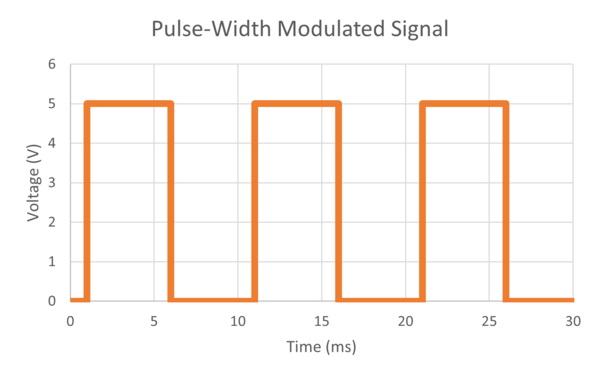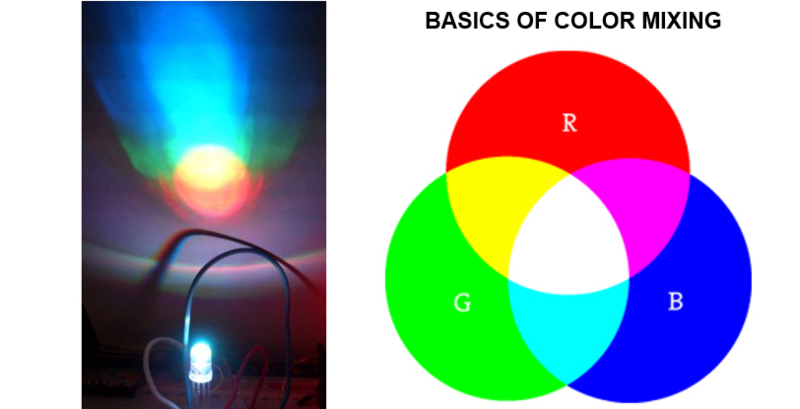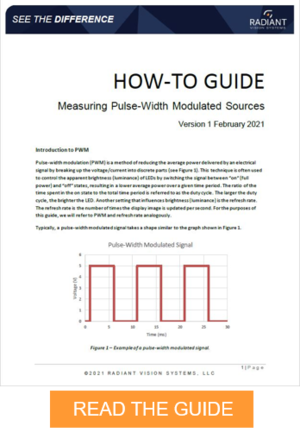How To Measure Pulse-Width Modulated LED Sources
Pulse-width modulation (PWM) is a method of reducing the average power delivered by an electrical signal by breaking up the voltage/current into discrete parts. This technique is often used to control the apparent brightness (luminance) of LEDs by switching the signal between “on” (full power) and “off” states, resulting in lower average power used over a given time period.
The ratio of the time spent in the on state to the total period is referred to as the duty cycle. The larger the duty cycle, the brighter the LED.

Typically, a pulse-width modulated signal has a shape similar to this.
Note in the graph above how the voltage switches between 5 Volts (V) (“on” state) and 0 V (“off” state). The signal in this example has a pulse-width of 5 milliseconds (ms) because that is the amount of time it spends in its “on” state during each of its 10 ms periods. We can calculate the duty cycle for this signal by dividing the pulse width by the period to determine this signal has a duty cycle of 0.5, or 50% (the value is typically expressed as a percent).
Applications of PWM for LEDs
Perhaps one of the most common application of PMW is for dimmable LED bulbs.1 Rapid light pulses can appear to the human eye as just a steady, but dimmer light. The apparent brightness (luminance) of the light can be adjusted based on the percentage of time the lights are in an “on” pulse mode. If the on time is 100%, the light is at full brightness, if the duty cycle is 50% on, the light will appear dimmed to half brightness. When applied to RGB LEDs, PWM can be used for color mixing by varying the brightness of red, green, and blue elements to change the resulting composite color appearance.

PWM can be used to mix colors of light: with RGB (red/green/blue) LEDs, it enables control of how much of each color is present in the mix by dimming each to varying degrees. (Images © Sparkfun)
Today, many types of display screens—such as notebook computers with backlit LCD screens—also rely on pulse-width-modulated LEDs to adjust screen brightness. However, the frequency of the pulses must be carefully controlled to prevent contributing to a “flicker” effect, which can cause eye strain and headaches in viewers.2 Another setting that influences luminance of a display and perceived flicker is the refresh rate: the number of times the display image is updated per second.
How to Measure PWM LEDs
Designers and manufacturers of devices that use pulse-width modulated LEDs must be able to measure luminance performance for quality assurance before putting products on the market. However, measuring PWM LED sources presents some challenges. When taking measurements of displays and LEDs that are pulse-width modulated, the results can vary from measurement to measurement, depending on the portion of the duty cycle and exact number of pulses that any given measurement happens to catch.
To determine the best method for accurately measuring the luminance of PWM sources, Radiant recently performed a series of tests in one of our labs. The tests were done using a Radiant ProMetric® I-16 Imaging Colorimeter with TrueTest™ Software. Results showed that it is possible to remove the effects PWM has on luminance measurement accuracy. Ultimately, a measurement needs to capture enough pulses to minimize the effects of slight differences in the total number of pulses measured.
We’ve developed a complete set of guidelines and methods for calculating and designing an effective test set up for PWM sources, published in our How-To Guide for Measuring Pulse-Width Modulated Sources. The Guide contains techniques that users can apply to any type of PWM LED testing using Radiant ProMetric imaging systems with TrueTest. To learn more about PWM testing, read the Guide, or email [email protected] with further questions.

CITATIONS
- Szolusha, K., "Dimming LEDs with pulse-width modulation", Electronic Engineering Times (EE Times), January 28, 2013
- Reverand, C., “Why Pulse-Width Modulation (PWM) is such a headache”, Notebook Check, December 18, 2017
Join Mailing List
Stay up to date on our latest products, blog content, and events.
Join our Mailing List
